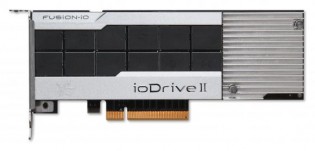What we do know is that Apple is spending mountains of money on a new breed of hardware device from a company called Fusion-io. As a public company, Fusion-io is required to disclose information about customers that account for an usually large portion of its revenue, and with its latest annual report, the Salt Lake City outfit reveals that in 2012, at least 25 percent of its revenue — $89.8 million — came from Apple. That’s just one figure, from just one company. But it serves as a sign post, showing you where the modern data center is headed.
Inside a data center like the one Apple operates in Maiden, North Carolina, you’ll find thousands of computer servers. Fusion-io makes a slim card that slots inside these machines, and it’s packed with hundreds of gigabytes of flash memory, the stuff that holds all the software and the data on your smartphone. You can think of this card as a much-needed replacement for the good old-fashioned hard disk that typically sits inside a server. Much like a hard disk, it stores information. But it doesn’t have any moving parts, which means it’s generally more reliable. It consumes less power. And it lets you read and write data far more quickly.
But that’s only one way to think about it. The same card can also act like a beefed-up version of a server’s main memory subsystem — the place where the central processor temporarily caches data it needs quick access to. You see, today’s super-fast processors have outstripped not only the hard disk, but main memory — the hard disk is too slow, the memory too small — and with its flash cards, Fusion-io aims to remove both bottlenecks.
READ MORE: Apple and Facebook Flash Forward to Computer Memory of the Future

